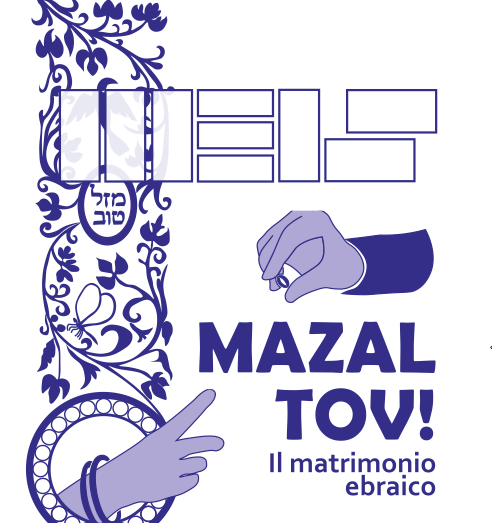From the Bible to a vibrant present

Yesterday, today, tomorrow: The Jewish marriage is nurtured by precepts and rites of the past, it is the emblem of continuity, it has its roots in the Bible; yet it coexists with a vibrant present, dialogues with the culture in which it is immersed, marks the birth of a new family. “Mazal Tov!” exposes this very balance between ancient and modern, combining precious documents with works of contemporary art. At the centre there are dozens of stories; fragments of centuries long amorous discourses and fixed forever through objects; acts; shots. The first halls illustrate the two phases and practices that make up the wedding ceremony: the Qiddushin (or Erusin) and the Nissuin. Formerly celebrated separately, they are now held together, one immediately following the other. What makes them peculiar is the setting under the chuppah, the canopy of the fabric that symbolically unites under the same roof the two spouses; the signature of Ketubbah, the nuptial ceremony born also with the aim of protecting women rights and that over time has been enriched by the very fine decorations, and the breaking of the glass, immortalized by many films and images. To tell in a clear and thorough way all the steps chosen to combine different works and communicative tools: on display will be the precious Ketubbot of the 17th and 18th century held by Estensi Galleries of Modena (Biblioteca Estense Universitaria); the theatre of the Genoese artist Emanuele Luzzati from the Jewish Museum of Bologna and the footage of a contemporary wedding.
The exhibition continues with a reflection on the recognition of Jewish marriage by the Italian state and the story -through family heirlooms- of the traditions that with time have characterised the wedding: the dowry, the gifts for the groom and the bride (which may vary from a complete edition of the Talmud to a designer watch) and the production of occasional compositions.
Among the pieces on display, an object with a history to be rediscovered: the album of dedications made by the playwright Sabatino Lopez in honour of the wedding of his brother Corrado and his wife Ada Sadun. Literary critic and successful playwright in the Milan of the early 20th century, Lopez decided to give the couple a completely original gift decorated with the signatures of friends and colleagues. Among the pages stand out in fact autograph texts -among others- by Giovanni Pascoli; Giovanni Verga, Giosuè Carducci; Eleonora Duse; Giacomo Puccini; Federico De Roberto and many other protagonists of Italian literature and theatre.
To enrich the exhibition also are works of contemporary art: Sigalit Landau’s “Salt Crystal Bridal Gown”, a project in collaboration with photographer Yotam From -which follows the process of crystallization of a black dress immersed in the Dead Sea and is inspired by the work “The Dibbuk” by S. Ansky, the story of a young bride possessed by the malicious spirit – Dybbuk – of her deceased lover during the time she’s engaged with another man.
With ‘Salt Bride’ Landau tried to emulate the romance and sorcery motives of the story. The crystalized salt on the submerged dress symbolizes supernatural forces, bewitching the black garment into a white wedding gown
Florah Deborah, French by birth and Milanese by adoption, reworks and makes the visitor understand the mikveh, the ritual bath in special tanks full of rain or spring water that women perform on the eve of marriage. Her work “Una per Tutte, Tutte per una” was created specifically for MEIS. The work on canvass by Jenny Hassan, a Roman artist, re-elaborates the chalice of the bride and groom. The sentence that frames it is a verse of Psalm 137 that is pronounced aloud during the breaking of the glass in memory of the destruction of the ancient Temple of Jerusalem.
“In this exhibition – explains the architect Gallerani, who is responsible for its organisation- there are the traditions and the typical characteristics of the Jewish wedding, with its specific and unique peculiarity, but there are also the stories of the people who had owned some of the objects on display, the emotions of those who gifted us with the shots of their most beautiful day. Even though traditions can differ, the joy of sharing a happy moment is the same for everyone”.
A space that allows the immersion in the Jewish wedding celebrated in our day was not lacking: the MEIS has launched in recent weeks the call to action “A love to share” to collect photos of Italian married couples that will be displayed in the exhibition; a visual journey from 1930s to 21st century. A project also enriched by historical photos from the archive of the Contemporary Jewish Documentation Centre Foundation of Milan, a precious resource that tells the life of Italian Jews in the early twentieth century.
Videos will also create an immersive experience involving the viewer and making him experience the joyful atmosphere of the festivities; while ephemeral objects, wedding favours and invitations will witness the present of a rite that dates back thousands of years ago. “With this exhibition – concludes the curator Sharon Reichel – we wanted to deepen the relationship that binds objects to people and, together with historical artifacts, we decided to open some windows on the contemporary world to make a tangible understanding of how Judaism is a living religion and culture. Often visitors who come to our museum talk about the Jews in the past tense, we want them to start doing so in the present tense and, why not, also in the future”.
(Above, the poster image of the exhibition reads “Mazal Tov! The Jewish wedding)
Translated by Oyebuchi Lucia Leonard and revised by Antonella Losavio, students at Trieste University and the Advanced school for interpreters and Translators of Trieste University, interns at the newspaper office of the Union of the Italian Jewish Communities.
